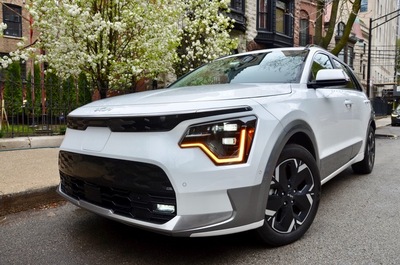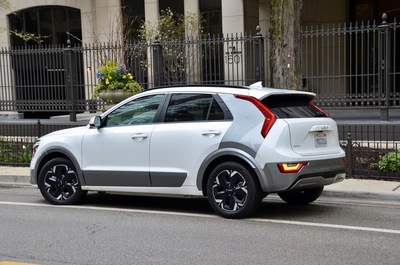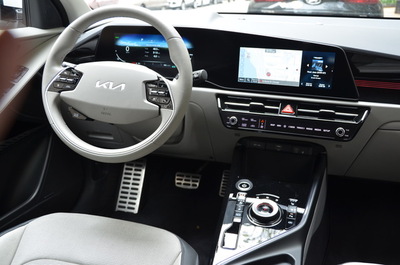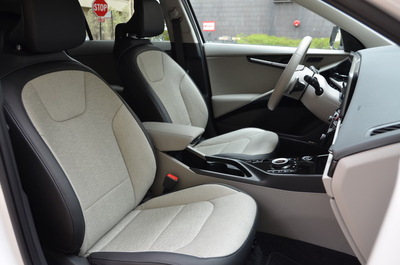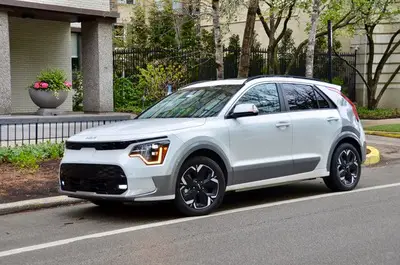2023 Kia Niro Review By Larry Nutson
2023 Kia Niro
Lighter, larger, and more efficient
By Larry Nutson
Executive Editor and Bureau Chief
Chicago Bureau
THE AUTO CHANNEL
Electric vehicles are not a new development. The EV was invented in the United Kingdom in 1884. Now 139 years later they have reappeared. And now, today, we are in the midst of remaking transportation.
Pure battery-powered electric vehicles (EV) perform and drive very well. They are quiet and comfortable. Personally, I consider EVs well suited as urban/city cars, or as the secondary vehicle in a household fleet. I’ll say, though, I expect my consideration to change over time as we move to the second and third generations of these new modes of transport.
The Kia Niro is now in its second generation with the launch of the 2023 model. This compact utility vehicle (CUV) is available with a choice of hybrid (HEV), plug-in hybrid (PHEV) and all-electric (EV) powertrains.
The Niro has all-new exterior and interior styling. The overall architecture is stronger and lighter. Niro models are larger in every dimension, including class-leading passenger and cargo volume.
On the safety front, Niro is equipped with a long list of collision warning, collision intervention, and driving control assistance features.
Battery vehicles require a focus on features that help optimize energy-saving and cruising range for year-round driving. In addition to aerodynamic design choices and body weight reduction efforts, systems and equipment are needed to reduce energy consumption, especially power used for heating in cold climates. The Niro has a heat pump system for both heating and air-conditioning, and available seat and steering wheel heaters.
All Niro models are front-wheel-drive. A 6-speed dual-clutch automatic transmission is standard in HEV and PHEV.
The Niro HEV features a 1.6-liter four-cylinder engine coupled with a 32kW permanent magnet synchronous electric motor, for a combined maximum power output of 139 horsepower and 195 lb.-ft. of torque. Niro HEV has an EPA-rating of 53 mpg combined (when equipped with 16-inch wheels) and a driving range of 588 miles. When equipped with 18-inch wheels, the HEV is EPA-rated at 49 mpg combined.
The Niro PHEV pairs the 1.6-liter engine with a 62kW electric motor, for a total system output of 180 hp and 195 lb.-ft. of torque. When it is connected to a Level 2 charger, the Niro PHEV can refill its 11.1-kWh lithium-ion polymer battery in under three hours. Fully charged, the all-electric range (AER) EPA-rating is 33 miles.
The all-electric Niro EV is powered by a 64.8 kWh battery and a 150kW (201-horsepower) motor with DC fast-charging capability as standard. Plugged in to a Level 3 fast charger, the Niro EV can replenish 10 to 80 percent in under 45 minutes, at a maximum charging capability of 85 kW. The 11kW onboard charger also helps recharge the Niro EV in under seven hours on a Level 2 charger. EPA-rated AER for the Niro EV is 253 miles.
An optional heat pump and battery warmer help preserve range in cold temperatures. The Niro EV will be available in two trims: the well-equipped standard model is Wind, while the fully loaded model is Wave.
Actual all-electric range, mileage, and total range will vary with options, driving conditions, driving habits and your vehicle’s condition. There are several reasons you might need more range than you think. One is that automakers recommend you charge the battery to 80% or 90% on a regular basis — and try not to drop below 10% if you can avoid it — to extend battery life, saving a full 100% charge for long trips. That means you’re immediately cutting the EPA-estimated, manufacturer-advertised range by up to 30% for daily use if you want maximum battery longevity.
My drive experience in the new Niro was in the EV model. With plenty of horsepower and good torque performance is brisk. Acceleration to 60 mph is in 7.1 seconds, which is plenty responsive for a family vehicle.
The Niro EV would be very well suited to serve my daily lifestyle around my Chicago home. However, a long road trip might present a bit of a challenge since the charging infrastructure along the Interstate highway system need a few years to develop.
If I were buying, the Niro PHEV would be my choice. In the city I could drive on battery power. Out on the open highway the gasoline engine takes over for a long trip. A PHEV is a good interim step for someone who wants to move in the “green car” direction but is not yet able to fulfill their typical driving needs with a pure EV.
More facts and figures on the 2023 Kia Niro can be found at www.kia.com.
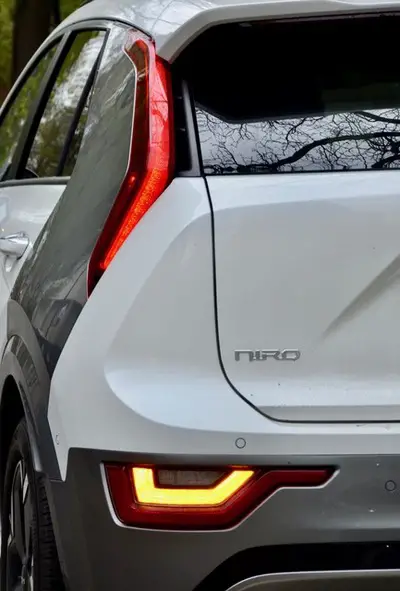 |
On a final note, under the Inflation Reduction Act (IRA), leasing is categorized as commercial business and therefore exempt from regulations that require the vehicle and battery components to be made in North America. Most EVs for sale today do not qualify for the full tax credit because of where the vehicles or components are built.
Kia has said they will look to increase leasing on their EVs to lower the pricing and increase sales.
The future is electric. Happy motoring!
© 2023 Larry Nutson, the Chicago Car Guy



